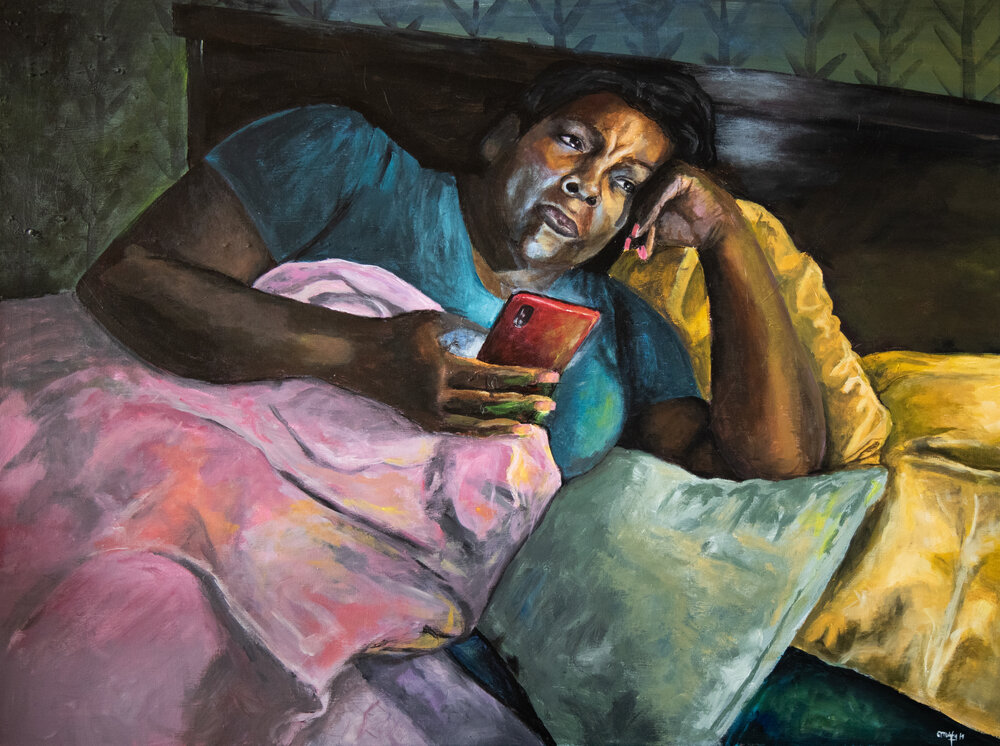Everybody and Dey Grammy

By: Natalie Willis NAGB
Whether we were watching and waiting for the storm to hit directly, or watching and waiting for it to pass from the safety of our own sofas, Christina Wong’s “Everybody and Dey Grammy #hurricanedorian” (2019) struck a cord (and plucked on heartstrings) for all of us. From the hashtag to the sentiment of everybody collectively waiting with bated breath, we felt Hurricane Dorian as a nation — not in a nationalist sense, but rather as people living in, from and tied to this landscape, “born Bahamian” or otherwise.
We used to be glued to the radio, tracking out coordinates on maps and hoping and praying for the best. Nowadays we get so much information it’s overwhelming. Is it the knowing or the not-knowing that’s worse? Wong’s depiction of a grandmother on the sofa at first gives us a sort of Renaissance imagery with the quality of light but something is different. The light isn’t the warm yellow of the sun, it’s too blue – it’s the soft glow of a screen in the dark. Painted in a manner that harkens to older styles of documenting the times, it contains undeniable signs of our current and intensely digital contemporary.
With her use of a hashtag in the title of the work, Wong also makes reference to the influx of images, videos and information digitally that we found ourselves inundated with surrounding the storm. If you watched the news or if you were on social media at the time, the content was unavoidable and it was as terrifying as it was heartbreaking. I personally remember my angry disbelief at the digital mock-ups that were released showing Grand Bahama island underwater, shouting about “trauma porn” and “fear-mongering”, not realising that it was the reality because it never had been before. We are in a climate crisis, plain and simple, and we can’t afford to turn our backs on the truth of it like so much of the privileged “developed” world has been able to.
We often hear of older generations saying how “things weren’t that bad” growing up and how social media makes things worse. Social media has a dark underbelly, that much is certain and uncontestable. But we live in an era where fact-checking biased news streams is available at the click of a button; that is both a blessing and a curse. When we can’t trust the news content that comes to us when we have had the lie about unbiased media busted wide open, it’s hard to trust your eyes and senses and that creates a certain kind of anxiety.
The nervousness and despair of Wong’s image aren’t just around the storm, but around the uncertainty of the time we live in. We can no longer pretend the media is unbiased (and it hasn’t been for quite some time now) and we live in a space that is increasingly untenable for our survival. It’s scary. Yet, we feel that all some of us can do is wait and watch, like Wong’s grammy figure.
This is not entirely the case, however. What we found with the disaster around Dorian was also an incredible, immediate response by those of us with phone and internet access (which is the majority of the population) to mobilize for rescue and aid to those trapped and displaced in Grand Bahama and Abaco during the storm. Whatsapp, Twitter and Facebook were buzzing with activity around people’s status and whereabouts and needs during the storm; those of us who were watching from relative safety did our part to reach those with the means to help those stranded and desperately clinging to survival (figuratively and metaphorically).
Phone and internet access became a matter of life and death in a painfully literal sense and they were still imperative to relief efforts immediately after. Hierarchy and protocol are the currency of old institutions and government, where ideas of a “long game” and long term plan are meant to be the mindset but when you have to deal with this in the very heavy immediate aftermath, you need to move quickly and this is precisely what people did. Small grassroots groups and NGO’s got themselves out as soon as they were able to, while big-picture thinking happened elsewhere. The connectivity of the digital era is so often spoken of as our downfall but it’s also what saved lives for this, the most difficult environmental disaster we have ever faced in this country. It’s something that deserves a retweet.
“Refuge” is on view at the NAGB through to March 29th, 2020. View this work by Christina Wong and others as creatives in the nation respond to the storm.

“Everybody and Dey Grammy #hurricanedorian” (2019), Christina Wong, acrylic on canvas, 40 x 30 inches. Part of the Dawn Davies Collection.